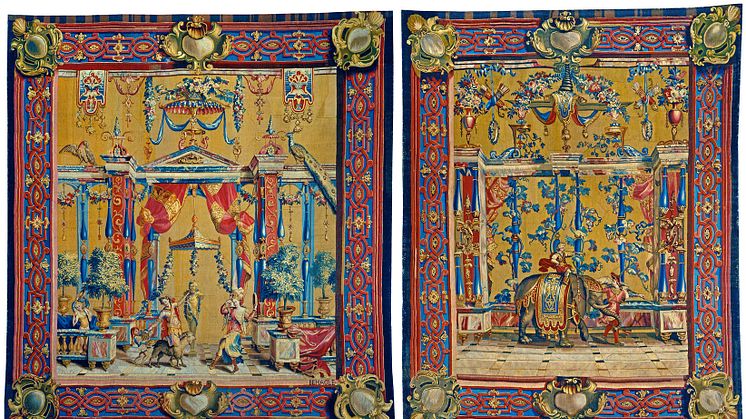
Press release -
Nationalmuseum acquires and repatriates a piece of Sweden’s cultural heritage
Thanks to a generous donation, Nationalmuseum has been successful in its bid to purchase and repatriate four woven tapestries manufactured at Beauvais. Commissioned in 1695 by Carl Piper for his residence in Stockholm’s old town, the wall hangings are still in fabulous condition after spending over a century in Denmark and the United States.
Carl Piper (1647–1716) was a prime example of the commoners who rose through the ranks of the government bureaucracy during the reign of Karl XI, supplanting the old aristocracy. Piper was ennobled in 1678 and made a baron and a count in 1697. Seven years later he married Kristina Törne (1673–1752), the daughter of his stepbrother. In 1692, as a gift from his father-in-law, Piper received a large property in Gamla stan, Stockholm’s old town, which is now known as Petersenska huset. The foremost Swedish architect of the time, Nicodemus Tessin the Younger (1654–1728), was commissioned to modernize and furnish the Piper residence.
Tessin’s correspondence with Daniel Cronström (1655–1719), the Swedish envoy to Paris, documents the original purchase of the recently acquired tapestries, along with another suite of tapestries, fabrics, chair covers, and fashionable, high-quality furniture. The correspondents discuss the choice of manufacturer, artist, motif, border, and dimensions for the “Grotesques de Berain” series, as the tapestries came to be known in the 19th century. From Cronström’s letter of 7 January 1695, we now know that the patterns for this suite of tapestries were designed by the painter Jean Baptiste Monnoyer (1636–1699), rather than the better-known Jean Berain (1640–1711). In the same letter, Cronström commends two suites of tapestries, both of which would suit the newly furnished main floor of the Piper residence. His chosen motifs can be adapted to the relatively low ceiling height of the rooms. He recommends one suite of “Port de mers”, a harbour scene (this suite survives in private ownership at Björnstorp in Skåne), and one suite of “Grotesque”, both to be manufactured at Philippe Behagle’s tapestry works in Beauvais. Grotesque is a style of ornamentation inspired by Classical decorative painting, which reached a wider audience through Raphael’s frescoes in the Vatican, painted in the late 15th century. The first grotesque tapestry suite manufactured by Beauvais was woven in 1688, it is believed, and remained in production until 1732, proving immensely popular. The fact that the motif was easily adjustable in size and could be combined with a wide variety of borders contributed to its popularity.
Berain designed a new border for Piper’s tapestries, but it did not incorporate Piper’s coat of arms or monogram, since these details were considered too time-consuming and would have delayed the order. Instead, Cronström suggested ordering chair covers bearing Piper’s monogram to match the tapestries. Several of these chair covers have survived and can now be found in the Metropolitan Museum of Art, Kungliga Husgerådskammaren (the Swedish Royal Collections), Nationalmuseum, and private collections. After Piper took delivery of the tapestries in Stockholm in December 1695, Tessin informed Cronström that his client was very happy with them. Thanks to the correspondence between Tessin and Cronström, the two suites of tapestries ordered by Piper are the best-documented personal orders for French tapestries from the 17th century. This is also the first documented order for tapestries with matching chair covers.
We still know little about what happened to the four recently acquired tapestries after they were installed in the Piper residence in early 1696. Piper continued his career at court, following Karl XII into battle from 1700 until nine years later, when he was taken prisoner after the battle of Poltava. He died in captivity in 1716. The tapestries probably left Sweden in the 19th or early 20th century. In 1909 they were sold by the Danish collector George Jorck (1865–1955), along with another two tapestries from the same suite plus a fragment, to Mrs Louise Mackay, an American collector. She later donated the fragment to the Victoria and Albert Museum in London. The tapestries then passed to her son, Clarence H. Mackay (1874–1938), a prominent collector of antique weapons and woven tapestries. After his death, they were sold at Christie’s in New York, where the suite was split up. Two of the tapestries were purchased by other buyers and are now in museum collections in England and Spain.
Nationalmuseum’s acquisition of the tapestries was made possible by a very generous bequest from Mr Gunnar Trygg (1924–2015) and Mrs Ulla Trygg (1924–2015) of Sala, who, except for some minor bequests, left their entire estate to the museum. Nationalmuseum has no budget of its own for new acquisitions, but relies on gifting and financial support from private funds and foundations to enhance its collections of fine art and craft.
Press contact
Hanna Tottmar, Press Officer, press@nationalmuseum.se, +46 767 234632
Categories
Nationalmuseum is Sweden’s premier museum of art and design. The collections comprise older paintings, sculpture, drawings and graphic art, and applied art and design up to the present day. The museum building is currently under renovation and scheduled to open again in 2018. In the meantime, the museum will continue its activities through collaborations both in Sweden and abroad as well as temporary exhibitions at the Royal Swedish Academy of Fine Arts, Fredsgatan 12 and Nationalmuseum Design at Kulturhuset Stadsteatern in Stockholm. Nationalmuseum has partnerships with Svenska Dagbladet and the Grand Hôtel Stockholm, and acknowledges the support of FCB Fältman & Malmén.

